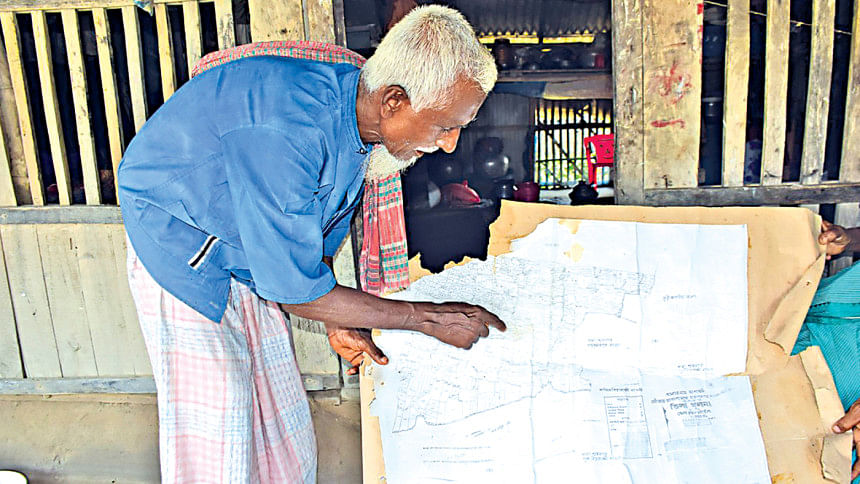'We are surviving by fighting the river's current,' said Morjina Khatun, 50, of Katmarchar village in Koyra upazila of Khulna district, wiping away tears. Morjina Begum's struggle began after her husband Nurul Islam died in 2015. Natural hazards have made her struggle even more difficult.
'Cyclone Amphan caused extensive damage to my land. The entire land was submerged in salt water. A part of the land was washed away by the river. Before Cyclone Amphan, the land used to yield good crops. Now the crops are not good. I catch shrimp fry in the river to support my family,' said Morjina Khatun.
After her husband's death, Morjina moved to her father's house. She earns a living by cultivating the land she received from her father. She has a family consisting of one son and two daughters. Morjina has to struggle a lot to earn money. Even though her son works outside, he cannot earn much due to his illness.
I met Sudha Rani Sarkar, 60, the head of a female-dominated household in Hazatkhali village of Koyra upazila. Thirty years ago, her husband Haro Chandra Sarkar died in a road accident. Since then, Sudha Rani has been carrying the burden of the family with her daughter. She had to struggle a lot to raise her daughter. Due to poverty, Sudha Rani worked from home in Khulna city, leaving her daughter with a close relative. Her house was submerged during Cyclone Amphan for about a year. Sudha's family could not survive by cultivating the small amount of land she received from her husband, so she had to undertake other work.
After Cyclone Amphan in 2020, many families lived on the Hazatkhali embankment in Koyra upazila of Khulna district. All their houses and agricultural land were under salt water. Sudha Rani and many other female-headed households lived on the embankment. Not only Cyclone Amphan, but frequent natural disasters in the region have hit female-headed households particularly hard. These disasters rendered their meagre agricultural land unproductive.
Rich Farmers Are Day Labourers
The crisis of female-headed households is distinct, but overall, all families bear the burden of natural hazards. Due to repeated disasters, once-wealthy farmers on the coast of Bangladesh are now making a living as day labourers. Once, they survived on rice produced from their own land, but now their families are in dire straits. It is very difficult for them to manage three meals a day.
Abdus Salam, 62, once made a living by cultivating rice on his own land. His family lived on the rice they harvested. But natural disasters have taken away those opportunities. Now he survives as a daily wage worker.

Farmer Abdus Salam's home is in Bonnyatola village in Shyamnagar upazila of Satkhira district on the southwestern coast of Bangladesh. His house and land were under salt water for about a year after Cyclone Amphan in 2020. The house was submerged by tides from the Kholpetua River. The damage to his house is still visible. Standing in front of his cyclone-damaged home, Abdus Salam points to his land. In some places, a layer of sand has accumulated; in others, a new canal has formed. A large part of his land has been overtaken by a newly built embankment. Much of his land has been lost to river erosion. At one time, Abdus Salam owned 150 decimals of land. Now only 22 decimals remain—and even that has become unproductive.
Another affected farmer is Amjad Hossain, 65, from Pratapnagar village in Asashuni upazila of Satkhira district. He owns a significant amount of agricultural land. However, due to the effects of frequent cyclones and high tides, much of it has become unproductive. Most of Amjad Hossain's land was destroyed by Cyclone Aila in 2009 and Cyclone Amphan in 2020. After Amphan, his land remained under salt water for almost two years.
Deepening Crisis
Rising sea levels, frequent cyclones, and other natural hazards have put the lives of millions in Bangladesh at risk. Agriculture is under threat due to increasing salinity and a lack of irrigation water. Millions have already been displaced to urban slums or migrated abroad. According to the Global Climate Risk Index, Bangladesh ranks seventh among the countries most affected by extreme weather over the last two decades.

A study by the Association for Land Reform and Development (ALRD) states that a lack of employment and the impact of natural disasters are among the main reasons for migration. Many families were displaced by Cyclone Aila in Shyamnagar, Satkhira. Those without land could not remain, as no employment was available. River erosion and cyclones like Aila have left people homeless in Satkhira (40 percent) and Khulna (33 percent). The study found that landlessness or becoming landless was the primary reason why residents left their homes after being devastated by natural disasters.
Millions of people in the southwestern coastal districts of Bangladesh have been affected by frequent cyclones. Cyclone Sidr in 2007, Cyclone Aila in 2009, Cyclone Fani in 2019, Cyclone Bulbul in the same year, Cyclone Amphan in 2020, and Cyclone Yas in 2021 have all caused extensive damage to the region. These disasters have had a severe impact on people's lives and livelihoods. Land degradation has further exacerbated their suffering.
Climate change is expected to cause a sharp rise in the number of displaced people in the future. According to the World Bank's latest Groundswell report, more than 210 million people worldwide could be displaced by 2050 due to climate change. Of these, over 40 million are expected to be in South Asia. In Bangladesh alone, an estimated 19.9 million people could be displaced.
Rafiqul Islam Montu is an independent journalist focusing on environmental issues, climate change, and coastal communities.


Comments